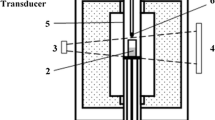Abstract
The rate of reduction of FeO in slags by Fe-C drops plays an important role in several metallurgical processes, including iron bath smelting. In this study, the rate of this reaction was determined by measuring the volume of CO generated as a function of time, and the reaction was observed by X-ray fluoroscopy. The drops entered the slag in a nearly spherical shape, remained as single particles, and for the major portion of the reaction remained suspended in the slag surrounded by a gas halo. The rate was found to decrease with carbon content for alloys with low sulfur contents. The rate decreased significantly with increasing the sulfur content. Based on the results and a comparison of the calculated rates, for the possible rate-controlling mechanisms, a kinetic model was developed. The model is a mixed control model including mass transfer in the slag, mass transfer in the gas halo, and chemical kinetics at the metal interface. At high sulfur contents (>0.01 pct), the rate is primarily controlled by the dissociation of CO2 on the surface of the iron drop. At very low sulfur, the rate is controlled by the two mass-transfer steps and increases as the gas evolution from the particle increases.
Similar content being viewed by others

References
T. Ibaraki, M. Kanemoto, S. Ogato, H. Koloyama, and H. Ishibara:Ironmaking Proc., 1990, vol. 49, p. 631.
R.J. Fruehan:Bath Smelting—Current Status and Understanding, Elliott Symp., Iron and Steel Society, Warrendale, PA, 1990.
H.W. Meyer, W.F. Porter, G.C. Smith, and J. Szekely:J. Met., 1968, vol. 10, p. 35.
P. Kozakevitch:J. Met., 1967, vol. 11, p. 57.
E. W. Mulholland, G.S.F. Hazeldean, and M.W. Davies:J. Iron Steel Inst., 1973, September, p. 632.
T. Gore and G.S.F. Hazeldean:Ironmaking and Steelmaking, 1981, no. 4, p. 167.
H. Gaye and P.V. Riboud:Metall. Trans. B, 1977, vol. 8B, pp. 409–15.
I.D. Sommerville, P. Grieveson, and J. Taylor:Ironmaking and Steelmaking, 1980, no. 1, p. 25.
G.R. Belton:Metall. Trans. B, 1979, vol. 10B, pp. 118–20.
R.J. Fruehan:Metall. Trans. B, 1977, vol. 8B, pp. 279–86.
T. Soma and F. Tsukihashi:Proc. Int. Symp. Physical Chemistry of Iron and Steelmaking, Canadian Institute of Mining and Metallurgy, Toronto, ON, Canada, 1982, p. 1–34.
S. Sun and G.R. Belton: Broken Hill Proprietary Laboratory, Newcastle, NSW, Australia, private communication, 1989.
F.J. Mannion and R.J. Fruehan:Metall. Trans. B, 1989, vol. 20B, pp. 853–61.
J. Hirschfelder, C.F. Curtis, and R.B. Bird:Molecular Theory of Gases and Liquids, John Wiley and Sons Inc., New York, NY, 1964.
D.R. Sain and G.R. Belton:Metall. Trans. B, 1976, vol. 7B, pp. 235–44.
Author information
Authors and Affiliations
Additional information
Formerly with Carnegie Mellon University
Rights and permissions
About this article
Cite this article
Min, D.J., Fruehan, R.J. Rate of reduction of FeO in slag by Fe-C drops. Metall Trans B 23, 29–37 (1992). https://doi.org/10.1007/BF02654033
Received:
Issue Date:
DOI: https://doi.org/10.1007/BF02654033



